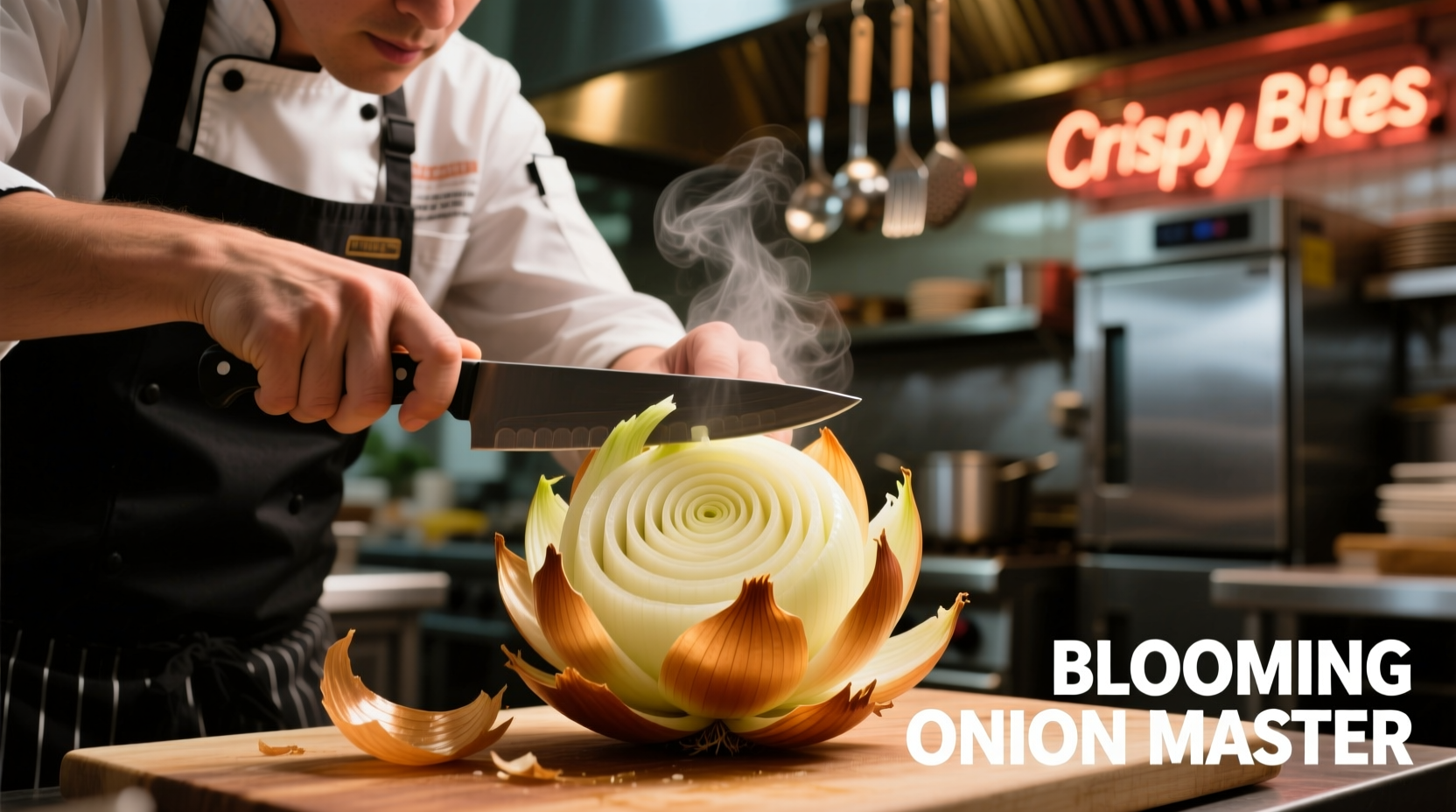If you're looking to create perfect restaurant-style blooming onions at home, a dedicated blooming onion maker simplifies the precise cutting technique required. These specialized kitchen tools guide your knife through onions at the correct angles and spacing, ensuring even 'petals' that bloom beautifully when fried. While not strictly necessary (you can use a sharp knife with practice), a blooming onion cutter guarantees consistent results, reduces waste, and makes the process significantly safer and faster for home cooks.
Creating that iconic blooming onion—the dramatic, flower-like appetizer famously served at restaurants like Outback Steakhouse—requires precise knife work that many home cooks find challenging. The right blooming onion maker transforms this intimidating technique into an accessible kitchen task, whether you're preparing game day snacks or impressing guests with homemade appetizers.
The Evolution of the Blooming Onion Technique
The blooming onion's popularity exploded in the 1990s with Outback Steakhouse, but the concept of cutting onions to create floral presentations dates back centuries. According to culinary historians at the American Food Roots Project, similar techniques appeared in European cookbooks as early as the 18th century, where chefs would carefully slice onions to create "onion roses" for decorative garnishes.
Modern electric deep fryers and specialized cutters have made the process more accessible to home kitchens. The U.S. Department of Agriculture's Food Safety and Inspection Service notes that proper cutting technique significantly impacts both the visual appeal and food safety of fried onions, as uneven cuts can lead to undercooked centers or burnt exteriors.
Types of Blooming Onion Makers Compared
| Type | Best For | Price Range | Learning Curve |
|---|---|---|---|
| Manual Blade Guides | Occasional use, limited storage | $8-$25 | Medium |
| Adjustable Plastic Cutters | Regular home use | $15-$35 | Low |
| Professional-Grade Metal Cutters | Frequent entertaining | $40-$75 | Low |
| Electric Onion Bloomers | Commercial use or large batches | $100-$250 | Medium |
How to Choose Your Ideal Blooming Onion Cutter
When selecting the best onion blooming tool for home kitchen, consider these critical factors:
Material Quality Matters
Plastic models dominate the budget market, but food-grade stainless steel blades in higher-end models maintain sharpness longer and resist corrosion from onion juices. The National Kitchen and Bath Association recommends avoiding cutters with visible seams where bacteria could accumulate.
Safety Features You Shouldn't Skip
Look for models with:
- Finger guards that prevent slips toward blades
- Non-slip bases for stability during use
- Blade covers for safe storage
The Consumer Product Safety Commission reports that onion-related kitchen injuries account for approximately 7% of all knife accidents in home kitchens, making proper safety features essential.
Mastering the Perfect Blooming Onion: Step-by-Step
Follow this professional technique whether you're using a specialized blooming onion cutter or improvising with kitchen tools:
- Select the right onion: Choose large, firm yellow onions with tight skins (about 3 inches in diameter)
- Prepare your workspace: Place a damp towel under your cutting board for stability
- Position the onion: Cut 1/4 inch off the top, then place cut-side down in your blooming tool
- Make the cuts: Press firmly through pre-marked guides or use a sharp knife to cut 1/8-inch slices from top to root (don't cut through)
- Create the bloom: Separate layers gently, then soak in ice water for 30 minutes to encourage opening
- Fry to perfection: Dip in batter and fry at 375°F for 2-3 minutes until golden

Beyond the Classic Appetizer: Creative Uses
Your onion blooming kitchen gadget isn't limited to the traditional fried appetizer. Try these innovative applications:
- Grilled vegetable platters: Create bloomed onions, brush with olive oil, and grill for Mediterranean dishes
- Stuffed vegetable bases: Fill bloomed raw onions with herbed goat cheese for elegant hors d'oeuvres
- Flavor infusion: Bloom small red onions and add to vinegar for beautifully striped pickling liquid
- Vegetarian "steaks": Use large bloomed onions as the centerpiece of plant-based meals
When You Don't Need a Specialized Tool
While a dedicated blooming onion preparation device delivers consistent results, you can achieve similar effects with basic kitchen tools:
- Use chopsticks placed on either side of the onion to prevent cutting all the way through
- Wrap rubber bands around the onion at 1/4-inch intervals as cutting guides
- Score the onion in a crisscross pattern for a different visual effect
Professional chefs at the Culinary Institute of America note that while specialized tools make the process faster, developing knife skills with traditional methods builds fundamental culinary abilities that serve you across many cooking techniques.
Maintenance Tips for Longevity
Extend the life of your onion blooming equipment with these care practices:
- Hand wash immediately after use (onion residue hardens and becomes difficult to remove)
- Store with blade protection to prevent accidental damage
- Check for rust spots monthly, especially on metal components
- Replace plastic models every 1-2 years as they become brittle from repeated washing
Remember that proper maintenance not only preserves your tool but also ensures food safety—onion particles trapped in cracks can harbor bacteria according to FDA food handling guidelines.
Final Thoughts
A quality blooming onion preparation tool transforms a challenging restaurant technique into an achievable home cooking skill. Whether you're entertaining guests or simply want to expand your culinary repertoire, the right cutter makes the process safer, more consistent, and significantly less intimidating. Start with a mid-range adjustable plastic model if you're new to the technique, then consider upgrading as your skills and interest grow.











 浙公网安备
33010002000092号
浙公网安备
33010002000092号 浙B2-20120091-4
浙B2-20120091-4